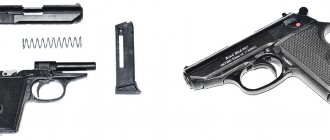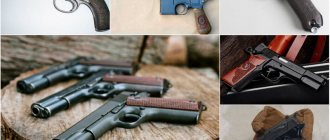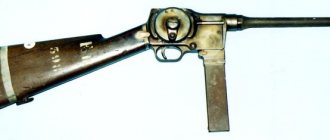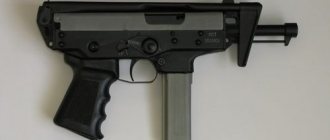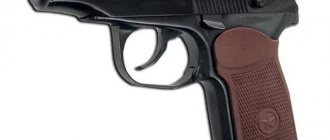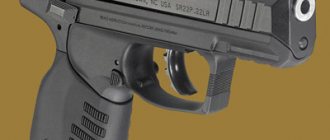Pistol Melior New Model
| Melior New Model caliber 7.65 mm (model 1920) |
In 1920, Belgian (formerly known as "Manufacture Liegeoise d'Armes a Feu Robar et Cie" and "ROBAR Fils & Co", and from the mid-1920s - "ROBAR & Co") to replace the Rosier "Melior" pistol a new pistol was developed and production began.
| M 1920 | M 1920/1925 | M 19201927 | ||
| Caliber, mm | 7.65×17 | 6.35x15.5 | 6.35x15.5 | 6.35x15.5 |
| Length, mm | 150 | 122 | 101 | 117.5 |
| Barrel length, mm | 90 | 59 | 48 | 59 |
| Weight without cartridges, kg | 0.635 | 0.350 | 0.240 | 0.365 |
| Store, count. cartridges | 7 | 6 | 6 | 6 |
The 1920 model pistol was also named Melior (Latin for “best”), but to distinguish it from the earlier model, it was designated “new model” - Melior New Model, and the Rosier pistol from that moment on was retroactively called the “old model”.
Melior New Model pistols were initially chambered for 7.65 and 6.35 mm Browning caliber cartridges, which differed in size, magazine capacity and sighting devices. Later, two more modifications were added to them - chambered for .22 LR and 9 mm Browning Short cartridges, developed on the basis of the frame of the 7.65 mm variant.
| Melior New Model caliber 7.65 mm (model 1920) |
The main feature of the Melior New Model pistol, in contrast to the “old model,” was the return spring, which was not located above the barrel (old model), but was put on the barrel (new model). As a result, the dimensions of the weapon were significantly reduced; the pistol became more compact and lighter, and also acquired a different appearance.
The Melior pistol of the new model looks very much like the Browning M 1910 and was undoubtedly created under its influence. However, its design differed from the 1910 Browning in a number of design features.
| Melior New Model caliber 6.35 mm (model 1920) |
| complete disassembly of Melior New Model caliber 6.35 mm (model 1920) |
incomplete disassembly of the Melior New Model caliber 6.35 mm (model 1920)
The main feature of the Melior New Model pistol was the bolt, which was a separate part and was inserted into the casing from the rear. In this position, it was fixed by a locking plate, which, being connected by a dovetail to the upper part of the casing, was located in the transverse direction and entered into a groove on the body of the bolt. The plate was held in place by a spring latch, which could be pressed to remove it and separate the casing and bolt. After this, the casing was easily separated from the pistol, for which it was enough to simply slide it forward through the barrel. The shutter itself remained in place.
The automatic operation of the pistol operates due to the movement of the free bolt.
The trigger mechanism is striker-type and allows firing only by self-cocking. Hidden type trigger.
| Melior New Model caliber 6.35 mm (model 1925) |
| complete disassembly of Melior New Model caliber 6.35 mm (model 1925) |
incomplete disassembly of the Melior New Model caliber 6.35 mm (model 1925)
There is a safety lever on the left side of the weapon behind the trigger. In addition, the pistol was equipped with an automatic frame safety located on the back of the handle, which was turned off when the pistol grip was correctly grasped with the hand. The frame safety lever had a length almost equal to the rear end of the handle, but after about 50,000 pieces of 7.65 mi caliber were produced, it was replaced by a shorter version. A similar replacement was made on the 6.35 mm pistol, starting at approximately serial number 100,000, but after about 10,000 more copies were produced, the manufacturer abandoned the frame safety altogether.
The weapon is fed with ammunition from a detachable box magazine with a capacity of 7 rounds of 7.65 mm caliber and 6 rounds of 6.35 mm caliber. The magazine release is located at the bottom of the handle.
The non-adjustable sights of a 7.65 mm caliber pistol consist of a rear sight and a front sight located on the casing, and in a 6.35 mm caliber pistol the rear sight of a modified shape is made integral with a latch holding the bolt locking plate with the casing.
On the cheeks, usually made of thick rubber, is the name of the pistol “Melior”.
| Melior New Model caliber 6.35 mm (model 1927) with frame fuse |
| complete disassembly of Melior New Model caliber 6.35 mm (model 1927) |
incomplete disassembly of the Melior New Model caliber 6.35 mm (model 1927)
Usually, the bolt-casing is marked MELIOR above the mark BREVETS-259178-265491-LIEGE-BELGIUM. However, on some copies there is the inscription MFR LIEGEOISE D'ARMES A FEU, which were probably intended for sale in those regions where the Melior trademark could not be used.
The Melior New Model pistol was modified several times in the 1920s.
In 1925, a 6.35 mm caliber variant was proposed. It also had a separate bolt, but its casing was open, which caused corresponding changes in the design of the pistol. At the same time, the weapon received a casing and frame of a new shape, as well as modified sights and a magazine latch. Such pistols were produced in small quantities and were probably an experimental version, with the goal of finding out whether any benefits could be achieved by changing the design of the model.
| Melior New Model caliber 6.35 mm (model 1927) without frame fuse |
Melior New Model caliber 6.35 mm (model 1927) view of the rear sight and bolt locking plate with casing
Since 1927, production of Melior New Model pistols began, incorporating the best solutions of the 1920 and 1925 models and aimed at improving production technology. The design was similar to the basic model with a closed casing and a separate bolt, but it received a modified casing, frame, sights and magazine latch. Initially produced with a shortened frame safety on the back of the handle, which was soon completely abolished.
A pocket model chambered for the .22 LR cartridge was created especially for export to the USA, called the “Mercury” and differing from the “Melior” mainly in appearance. Its casing was marked “MERCURY MADE IN BELGIUM”.
Melior New Model self-loading pistols were intended for self-defense at short distances and, due to their small size, especially the 6.35 mm caliber, were used as pocket weapons. Melior's "new model" pistols were fairly reliable quality weapons and were commercially successful and sold well into the early 1950s.
| Mercury (exported to USA) |
Encyclopedia of weapons
Pistol New Model Melior
Tactical and technical characteristics of New Model Melior: Caliber, mm — 7.65×17 Browning Length, mm — 150 Barrel length, mm — 90 Weight without cartridges, g — 635 Magazine capacity — 7
In 1920 by the Belgian company ROBAR Fils and L De KERCKHOVE (previously known as "Manufacture Liegeoise d'Armes a Feu Robar et Cie" and "ROBAR Fils & Co", and since the mid-1920s - "ROBAR & Co") To replace the Rosier pistol, Melior was developed and production of a new pistol began.
The 1920 model pistol was also named Melior (Latin for “best”), but to distinguish it from the earlier model, it was designated “new model” - Melior New Model, and the Rosier pistol from that moment on was retroactively called the “old model”.
Melior New Model pistols were initially chambered for 6.35 mm Browning and 7.65 mm Browning calibers, but in subsequent years two more modifications were added to them - chambered for .22LR and 9 mm Short cartridges, developed on the basis of the frame of the 7.65 mm variant.
The New Model Melior was similar in appearance to the Browning M1910, but its design was different.
The main feature of the Melior New Model pistol, in contrast to the “old model,” was the return spring, which was not located above the barrel (old model), but was put on the barrel (new model). As a result, the dimensions of the weapon were significantly reduced; the pistol became more compact and lighter, and also acquired a different appearance.
The shutter was a separate part and was inserted into the casing from the rear. In this position, it was fixed by a locking plate, which, being connected by a dovetail to the upper part of the casing, was located in the transverse direction and entered into a groove on the body of the bolt.
The plate was held in place by a spring latch, which could be pressed to remove it and separate the casing and bolt. After this, the casing was easily separated from the pistol, for which it was enough to simply slide it forward through the barrel. The shutter itself remained in place.
The automatic operation of the pistol operates due to the movement of the free bolt. The trigger mechanism is striker-type and allows firing only by self-cocking. Hidden type trigger.
On the left side of the weapon behind the trigger there is a safety lever. In addition, the pistol was equipped with an automatic frame safety located on the back of the handle, which was turned off when the pistol grip was correctly grasped with the hand.
The frame safety lever had a length almost equal to the rear end of the handle, but after about 50,000 pieces of 7.65 mm caliber were produced, it was replaced by a shorter version. A similar replacement was made on the 6.35 mm Melior pistol, starting at approximately serial number 100,000, but after about 10,000 more copies were produced, the manufacturer abandoned the frame safety altogether.
The weapon is fed with ammunition from a detachable box magazine with a capacity of 7 rounds of 7.65 mm caliber and 6 rounds of 6.35 mm caliber. The magazine release is located at the bottom of the handle.
The non-adjustable sights of a 7.65 mm caliber pistol consist of a rear sight and a front sight located on the casing, and in a 6.35 mm caliber pistol the rear sight of a modified shape is made integral with a latch holding the bolt locking plate with the casing.
On the cheeks, usually made of thick rubber, is the name of the pistol “Melior”.
Melior New Model self-loading pistols were intended for self-defense at short distances and, due to their small size, especially the 6.35 mm caliber, were used as pocket weapons. The pistol was a fairly high-quality weapon and sold well until the early 1950s.
Usually on the bolt-casing there is the marking MELIOR above the mark BREVETS-259178-265491-LIEGE-BELGIUM, but on some copies there is the inscription MFR LIEGEOISE D'ARMES A FEU. These pistols were probably intended for sale in regions where the Melior brand could not be used.
The Melior New Model pistol was modified several times in the 1920s.
In 1925, a 6.35 mm caliber variant was proposed. It also had a separate bolt, but its casing was open, which caused corresponding changes in the design of the pistol.
At the same time, the weapon received a casing and frame of a new shape, as well as modified sights and a magazine latch. Such pistols were produced in small quantities and were probably an experimental version, with the goal of finding out whether any benefits could be achieved by changing the design of the model.
Since 1927, the production of Melior New Model pistols began, incorporating the best solutions from the 1920 and 1925 models and aimed at improving production technology.
The design was similar to the basic model with a closed casing and a separate bolt, but it received a modified casing, frame, sights and magazine latch. Initially produced with a shortened frame safety on the back of the handle, which was soon completely abolished.
| Performance characteristics | ||||
| Melior 1908 | Melior 1920 | Melior 1920/25 | Melior 1920/27 | |
| Caliber, mm | .25 ACP | .32 ACP / .25 ACP | .25 ACP | .25 ACP |
| Length, mm | 116 | 150 / 122 | 101 | 117,5 |
| Barrel length, mm | 55 | 90 / 59 | 48 | 59 |
| Height | 90 | ? / 80 | 74 | 83 |
| Width | 22 | ? / 23 | 18 | 22 |
| Weight without cartridges, g | 350 | 635 / 350 | 240 | 365 |
| Magazine capacity, no. cartridges | 6 | 7 / 6 | 6 | 6 |

